SAC Bases:
Wright Field, Patterson Field /
Wright-Patterson
AFB |
|
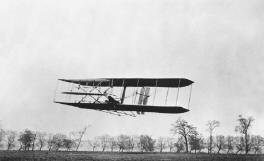 |
The history of Wright-Patterson AFB literally began with the origins
of manned, powered, controlled flight. Following their successful
proof-of-concept flights at Kitty Hawk, North Carolina, in December
1903, Wilbur and Orville Wright selected an 84-acre plot of land
near their home in Dayton, Ohio, to serve as their experimental
flying field, as they sought to transform their invention into a
practical flying machine. Here at the Huffman Prairie Flying Field
in 1904 and 1905 they developed the first practical airplane (the
1905 Flyer) and, as Orville noted, “really learned to fly.” Over
this prairie, now a part of Wright-Patterson AFB, the brothers
performed the first turn and circle in an airplane and solved the
final mysteries of flight. Here, too, they invented and used the
first successful aircraft catapult launcher. |
|
|
The brothers returned to the Huffman Prairie Flying Field
in 1910. This time the field served as home to the Wright Company School
of Aviation, the Wright’s flight exhibition company, and a test range
for their aircraft company. Among the graduates were Army Lieutenant
Henry “Hap” Arnold, who was sent to the school in 1911 to earn his
wings, and A. Roy Brown, the Canadian Ace who received the aerial credit
for downing Baron von Richthofen, the Red Baron. The Wright brothers
operations on the Huffman Prairie ended in 1916 when the aviation school
closed its doors. During these years, the Wrights had used the Huffman
Prairie as a research and development facility, flight test center,
logistics depot, and training field. These functions became precedents
for operations around the Huffman Prairie site for the rest of the
century. Even more important, the “can-do” spirit that Wilbur and
Orville brought to the flying field would inspire their heirs to push
aeronautical engineering to its technological limits.
|
World War I
When the United States declared war on Germany in 1917, the War
Department began a rapid expansion of its military facilities and
purchased McCook Field, Wilbur Wright Field, and the Fairfield Aviation
General Supply Depot. It was named McCook Field and opened on
December 4, 1917. This 254-acre leased complex was located just north of
downtown Dayton. It became a temporary home for the Airplane
Engineering Division of the U.S. Army Signal Corps until Langley Field
in Virginia could be completed, but by the end of World War I, 2,300
scientists, engineers, technicians, and support officers were working in
McCook’s 19 sections and 75 branches. In the postwar period, this force
would dwindle to an average of 50 officers and 1,100 to 1,500 civilians.
McCook Field’s achievements proved so substantial that in May 1919 all
experimental aircraft activities being handled at Langley Field were
transferred to McCook. The Air Service Engineering School at the
field evolved into the Air Force Institute of Technology. Among the
Engineering School’s first graduates in the Class of 1920 was Lieutenant
Edwin E. Aldrin who also served as the school’s operations officer and
whose son, Major Edwin “Buzz” Aldrin, would walk on the moon 49 years
later.
|
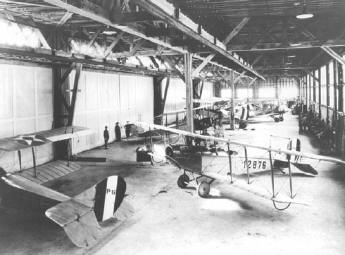 |
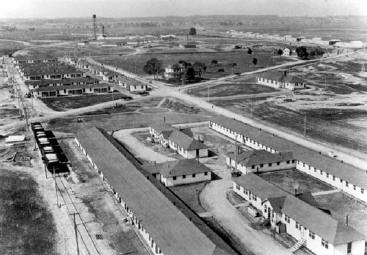 |
|
Curtiss JN-4D Jennys in McCook Field
main hangar, 1918.
|
Wilbur
Wright Field |
|
Construction of the
Fairfield Aviation General Supply Depot* began in the fall of 1917 on
forty acres of land immediately adjacent to Wilbur Wright Field that the
Army purchased from the Miami Conservancy District. The depot’s mission
was to provide logistics support to Wilbur Wright Field and the three
other Signal Corps Aviation Schools.
Rapid demobilization and restructuring followed the
conclusion of the Great War. On January 10, 1919, Wilbur Wright Field
merged administratively with the Air Service Armorer’s School and the
Fairfield Depot to form the Wilbur Wright Air Service Depot. Throughout
the years, the depot underwent numerous name and organization changes,
but was commonly referred to as the Fairfield Air Depot (FAD). In 1921
the depot became the home of the Property, Maintenance and Cost
Compilation Section, the earliest antecedent of the logistics component
of today’s Air Force Materiel Command.
|
Permanent Engineering Center
McCook Field had been built as a temporary experimental
wartime testing site and its shortcomings soon became evident. The
field’s short runways and obstructed approaches challenged pilots. Rapid
advances in aeronautical technology were producing larger, more powerful
aircraft that overwhelmed the field. It was becoming unsafe for
both aircrews and the local population. Its temporary buildings were
expensive to maintain and the field was hampered by the absence of a
railroad line. Finally, the rent for these inadequate facilities was
extremely high and landowners wanted to convert the land to more
profitable uses. These factors sent the War Department in search of a
new, permanent site for the Engineering Division.
When Dayton’s businessmen and citizens learned that
they might lose the engineering center, they seized the initiative. The
Engineering Division gave the community a stable and expanding economic
base. It was also a great source of pride for the city that considered
itself the birthplace of aviation. Furthermore, Dayton’s industries
directly benefited from the technology developed at McCook and the
skilled workforce that the Engineering Division attracted. Under the
leadership of the Patterson family (founders of the National Cash
Register Company), the city’s prominent citizens formed the Dayton Air
Service Committee to save the facility. The Committee soon reached an
agreement with the War Department to build a permanent engineering
facility in Dayton provided the land was donated to the federal
government. It then organized a 48-hour fundraising campaign that
garnered $425,000 of private money to buy the land and fund a monument
to the Wright brothers.
In 1924, the Dayton Air Service Committee purchased
4,520.47 acres of land northeast of Dayton and presented the deeds to
President Calvin Coolidge. The land donation included the previously
leased site of Wilbur Wright Field. The War Department combined this
gift with its adjacent site at the Fairfield Air Depot and redesignated
the entire acreage as Wright Field to honor both Wilbur and Orville
Wright.
|
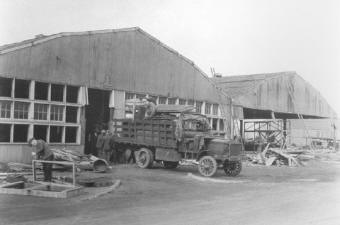 |
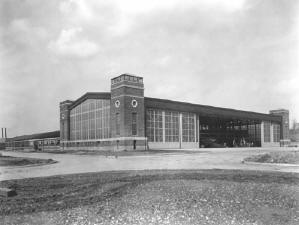 |
|
McCook Field facilities being
dismantled for transfer to Wright Field |
Building 31, Wright Field Assembly
Hangar |
|
|
The
transfer of equipment and operations from McCook Field to Wright Field
begun in March 1927 was essentially completed by June, although the last
of the equipment was not moved until May 1929. The formal dedication of
Wright Field was held on October 12, 1927 with Orville Wright raising
the first flag over the new engineering center. The dedication
established three precedents. It was the first time that an Army
installation was named for two civilians who had never been in military
service. It was the first time an installation was named for a living
individual. And, in all likelihood, it was the first time that an
individual so honored by the military service was present at his own
memorialization.
As the nation’s foremost aeronautical engineering
center, Wright Field became involved in every aspect of aircraft design
and production. During the 1930s, the engineering trend at the field was
toward diversification, expansion, and modernization of aircraft design.
Engineers and scientists worked to improve aircraft structure and
aerodynamics. They developed a wide range of experimental and production
aircraft categorized by mission: attack, pursuit, transport,
bombardment, observation, photographic, training, and rotary wing. Each
innovation served as a stepping stone to the next. Thus, the Boeing B?9
and Martin B?10 bombers paved the way for the B?17 and became
progenitors of the B?29 as Wright Field engineers tried to develop a
true long-range bombardment aircraft. Wright Field was also instrumental
in marketing aircraft to foreign nations. The work performed in the
1930s would soon provide America with a decisive edge. The aircraft that
won World War II were either in development or production when the
conflict began.
|
Patterson Field
Although the entire installation had been named “Wright Field” in 1924,
there was considerable community support to formally recognize the
Patterson family’s leadership in keeping the Engineering Division in
Dayton. This recognition occurred on July 1, 1931 when the War
Department redesignated that portion of Wright Field east of Huffman Dam
as “Patterson Field.” The area encompassed the original Wilbur Wright
Field, the Fairfield Air Depot, and the Wright brothers’ flying field at
Huffman Prairie. Patterson Field specifically honored Lieutenant Frank
Stuart Patterson, a son and nephew of the founders of the National Cash
Register Company. Lieutenant Patterson was a test pilot who lost his
life in the crash of his DH?4 aircraft during a test flight at Wilbur
Wright Field on June 19, 1918. The two fields remained physically
separated until after World War II, but their missions continued to be
closely intertwined.
|
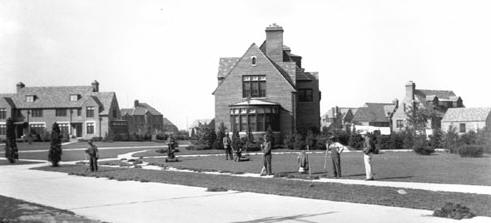 |
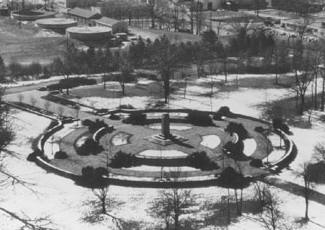 |
| Brick Quarters |
Wright Memorial |
|
|
Patterson
Field was a logistics center throughout the pre-war period. The
Fairfield Air Depot retained its title and operated as the major
organization on the installation. The depot had support responsibilities
in 28 states and serviced 28 of the Air Corps’ 50 stations in the United
States. In 1931 it had 15 officers and 550 civilians and generated a
monthly payroll of $67,000. Its headquarters moved from Building 1 (the
installation’s original depot structure) to the newly completed Building
11 in 1933. Several acres of Patterson Field were set aside in 1934 to
house a Transient Camp for temporary workers employed under
Depression-era programs. During 1934 and 1935, these men labored on a
number of projects such as the renovation of buildings and landscaping.
Young men residing in the Civilian Conservation Corps camp that was set
up on the field helped landscape the installation in 1935 and 1936.
The workers also contributed to the construction
of Wright-Patterson’s Brick Quarters. Built in an area described as “an
unsightly weed patch,” the 92 housing units were erected to house all
the officers assigned to Wright and Patterson Fields. Designers arranged
the $1,722,000 complex in the shape of a horseshoe with the Turtle Pond
centered along its main axis and the Officers’ Open Mess situated at the
crown of the curve. Large, private back yards enhanced the neighborhood
and created an atmosphere of informal tranquility in these junior
executive style homes. The jewel of the complex was Quarters 1, since
memorialized as “The Robins House” for its first occupant, Brigadier
General Augustine Warner Robins. It was the residence of the
installation’s senior officer.
As a depot, Patterson Field supported Air Corps
operations throughout the nation. It also played a key role in several
operations. In 1933, it hosted the Air Corps Anti-Aircraft Exercises and
the next year it modified and supported military aircraft assigned to
carry the U. S. Mail. When Lieutenant Colonel Henry “Hap” Arnold (a
former depot commander) initiated the long-distance Alaskan flight of
1934, Patterson Field prepared the aircraft and supported the operation.
The field was also the scene of the world’s first entirely automatic
landing which took place in 1937. New additions to the Patterson Field
community included the Air Corps Weather School in 1937 and the first
military Autogiro School in the United States. It opened in 1938.
Another landmark, the Wright Memorial, was dedicated on
August 19, 1940. This tribute to the Wright brothers was constructed by
the Dayton community on a 27-acre site owned by the Miami Conservancy
District. The Olmsted Brothers architectural firm designed the memorial
which sits atop a 100-foot bluff adjacent to Wright Field overlooking
the Huffman Prairie Flying Field. Funds raised by the Dayton Air Service
Committee in 1924 as part of its campaign to keep the Engineering
Division helped finance the monument. Six native American burial mounds
are also nestled about the memorial.
|
World War II
World War II profoundly altered both Wright and Patterson Fields. From a
combined population of 3,700 in 1939, the workforce at the two fields
would eventually peak at over 50,000. The workload shifted from a
40-hour week to round-the-clock operations. The faces of the two
installations also changed rapidly as massive construction programs
erected new work centers and housing complexes to accommodate wartime
operations. Existing facilities were modified and converted to new uses.
|
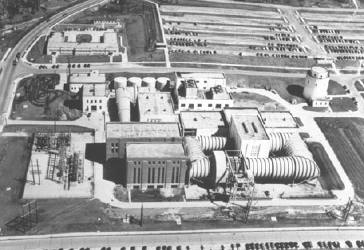 |
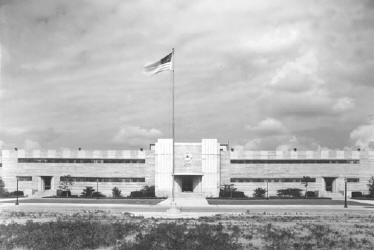 |
| Wind Tunnel Complex |
Air Service Command
Headquarters, Building 262 |
|
Numerous
laboratory structures joined the Wright Field complex. Among these were
the vertical wind tunnel (Building 27) for parachute testing and the
20-foot wind tunnel (the world’s largest). The huge Static Test Facility
(Building 65) was constructed to test the B?36 bomber. Engineers
designed and built an acoustical shell around the propeller test rigs
(Building 20A) so the constant droning would not disturb the sleep of
base personnel and the civilian community. Wright Field expanded in size
as well when the Hilltop area along National Road was acquired. This
land area became home to the Wright Field headquarters (Building 125), a
parade field, a barracks complex, and quarters for the prisoners of war
who were interned at the field.
Work at Wright Field centered on research,
development, and procurement, with emphasis on the latter. The race to
increase propulsion power and efficiency was the field’s most
significant R&D effort of the war. These efforts, for example,
eventually enabled heavy bombers to exceed 30,000 feet and the B-29 to
approach an altitude of 40,000 feet. The field’s engineers and
scientists conceived and put into production the airplanes responsible
for Allied victories.
|
Post War
Victory brought great celebration. It also gave Wright Field an
opportunity to educate the public on its achievements and the revolution
in aviation technology that World War II had spawned. Wright Field
hosted a two-day Army Air Forces Fair in October 1945 that attracted
500,000 people. The fair was so popular that base officials extended it
for a week. More than one million people from 26 foreign countries
observed displays of Army Air Forces operational and experimental
aircraft. The highlights of the event were exhibits of captured German
and Japanese aircraft, rockets, and equipment. In all, over $150 million
worth of equipment, much of it previously classified, was put on
display.
Victory also brought demobilization and a return to
“normal” operations. Procurement moved to the back seat as the
operational emphasis at Wright Field returned to research and
development, although the focus of the work shifted from
propeller-driven aircraft to jet propulsion. Wright Field also moved
away from developing, modifying, and improving individual items in favor
of a coordinated approach that emphasized new systems and models. In
late 1945 the Air Documents Research Center moved to Wright Field from
London. Working under T?2 Intelligence, a team of almost 500 people
catalogued, abstracted, indexed, and organized 55,000 captured German
documents representing the cream of Germany’s aeronautical research and
development. German aircraft and engines were also shipped to Wright
Field for analysis. Finally, Projects Overcast and Paperclip brought
prominent German scientists to the field where they contributed their
knowledge to the future of American aeronautical engineering.
When the war ended, Patterson Field hosted an
Army Air Forces Base Unit Separation Center that processed over 35,000
soldiers from the service. Peace also dramatically reduced the depot’s
supply and maintenance operations. In January 1946, depot operations
formally ended at Patterson Field when the Fairfield Air Depot was
officially inactivated and its functions transferred to Air Materiel
Areas.
|
Bases merged into Wright-Patterson AFB
As World War II was coming to an end, managers at both Wright
and Patterson Fields began to jointly plan and administer the two
fields. In 1945 they integrated the master plans for Wright and
Patterson Fields into a single document and increasingly administrated
the functions and services of the two fields as a single installation.
This practice was formalized in December 1945 with the establishment of
the Army Air Forces Technical Base, Dayton, Ohio, which consolidated the
two fields into an umbrella organization for administrative purposes.
The AAF Technical Base was redesignated on December 9, 1947 as the Air
Force Technical Base to reflect its status as part of the new,
independent United States Air Force. The final evolutionary step came
one month later. On January 13, 1948 Wright Field and Patterson Field
were officially merged into a single installation and redesignated
Wright-Patterson Air Force Base. To facilitate daily management,
Patterson Field became “Area C” and Skyway Park (located across Kauffman
and encompassing the area that is now Wright State University) became
“Area D” of the installation. Wright-Patterson AFB was assigned to
Air Materiel Command
|
The Cold War & Korea
Wright-Patterson Air Force Base became a
unified installation just as the Cold War began to heat up. The Berlin
Airlift, Korean War, and other Cold War activities directly impacted its
operations. The Berlin Blockade and Airlift began in June 1948 and
lasted until September 1949. The installation’s manpower soon rose from
a postwar low of 21,000 in 1947 to 25,000 in 1949. During this time, the
aircraft logistics support that made the airlift possible was directed
by Headquarters Air Materiel Command in Building 262. AMC managed the
transfer of the larger and faster C?54 transports to Germany and
maintained a pipeline of parts and supplies that kept the aircraft
flying. It also arranged for contract maintenance to handle the
overwhelming workload created by the operation.
When the Korean War broke out,
Wright-Patterson’s workload and labor force rapidly expanded to meet
wartime demands. Automation and decentralization became major trends at
Air Materiel Command. The rapid acceleration and expansion of aerospace
technology led to new, specialized research centers throughout the
country. Through the course of the 1950s, Wright-Patterson transferred its
large engine testing and ballistic missile development to these centers as
well as its electronic support systems, armament, and rocket engine work.
New tenant organizations added to the
flightline activity. The F-86Ds and F-104 Starfighters belonging to Air
Defense Command’s 97th Fighter-Interceptor Squadron (later redesignated
the 56th FIS) provided air defense for the industrial areas of the Miami
Valley from 1951 to 1960. The 58th Air Division also operated an air
defense control center for an eleven state area from 1955 to 1958.
|
Strategic Air Command
The Soviet Union launch of the
Sputnik space satellite made the Strategic Air Command aware that a
missile that put an satellite into orbit could also deliver a nuclear
bomb to its bases. B-52 bases had three squadrons of 15 planes each.
Each was converted into a strategic wing and dispersed to separate
bases.
Wright Patterson AFB acquired 465
acres on the northeast corner of the installation where it built the
West Ramp complex to house the SAC wing and its B-52 bombers and KC-135
tankers. The 42nd Bomb Squadron of from the 11th Bomb Wing became
the 4043rd Strategic Wing. It began operations at Wright Patterson
AFB on April 1, 1959, where it maintained six aircraft on ready alert.
It was also assigned the 922nd Air Refueling Squadron.
The 17th Bombardment (tactical) flew B-26s during
the Korean War. When it returned to the states in 1955, it began
flying B-66s. It was inactivated June 25, 1958. Redesignated
the 17th Bombardment Wing, Heavy, it was activated at Wright-Patterson
on November 15, 1962 and replaced the 4043rd Strategic Wing in February,
1963. It absorbed the 42nd Bomb Squadron and 922nd Air Refueling
Squadron. It trained to maintain proficiency in strategic bombing and
aerial refueling on a global basis. It furnished B-52s KC-135
aircraft and crews to SAC units in Vietnam from 1966 to 1975.
The 17th Bombardment Wing transferred to Beale
AFB, California, in 1975 thereby ending the strategic nuclear alert
mission at Wright-Patterson. |
The Vietnam Era
The Air Force opened the decade of the 1960’s with a
major restructuring that would govern operations at Wright-Patterson AFB
for the next thirty years. On April 1, 1961, the Air Force transferred
Air Materiel Command’s procurement and production functions for new
systems to the ARDC. It then redesignated AMC as the Air Force Logistics
Command (AFLC) and ARDC as the Air Force Systems Command (AFSC).
Routine business at Wright-Patterson soon gave way to
the growing requirements of the nation’s military operations in Vietnam.
Headquarters AFLC’s requirements for supporting the forces and bases in
the theater of war grew rapidly. By September 1964, AFLC was calling
upon the 2750th Air Base Wing for assistance. The wing immediately began
shipping materiel and providing support personnel to the combat theater.
It quickly became a prime procurer of loaders, revetments, and shelters.
In November 1965, the wing provided fifteen members for AFLC’s first Air
Force Prime BEEF (Base Engineering Emergency Force) mobility military
civil engineering force. Other base support over the years included
flight training, small-arms weapons training, vehicle operator training,
and laundry management courses.
On the Wright Field side of the installation, the
research laboratories and the Aeronautical Systems Division were busy
inventing and improving the systems used by warfighters. The
laboratories were developing jet fuels and lubricants for all services,
working on phased array radar and airborne lasers, exploring the use of
composite materials in structures, and pursuing stealth technology and
fly-by-wire technology.
Wright-Patterson AFB in 1960 had 100 tenants
representing 150 organizational units and boasted fixed capital assets
of over $208 million on base and $6 million off base. As in previous
conflicts, the base population jumped, this time from 25,000 to over
30,000 by 1964. It then declined before stabilizing between
25,000-26,000 for the duration of the war. Meanwhile, consolidation and
automation continued as trends in base support operations. |
1971-to Date
The end of the Vietnam War brought with it a period of
rapid transition and uncertainty within the defense establishment.
Mmany activities at Wright-Patterson AFB converted from government to
contract operations. Organizational changes occurred as the Air
Force moved away from its Vietnam-era structure toward one better suited
to the Cold War and the dynamic progress of technology.
Base flying operations in the post-Vietnam era
underwent dramatic changes. In 1975, the Air Force decided to retire
much of its aging fleet of administrative support aircraft and
reorganize the rest. The 2750th Air Base Wing transferred most of its
aircraft to the Military Aircraft Storage and Disposal Center in
Arizona.
The wave of historical interest spawned in the 1970s
was joined in the 1980s by an active concern with environmental
management. At Wright-Patterson, the environmental protection
initiatives included an investment of $37 million to modify and
modernize the base’s coal-fired heating plants. The base installed new
boilers and electrostatic precipitators to meet federal and state
environmental regulations and shut down three of its five heating
plants. Environmental managers also started surveying potentially
contaminated sites and developing remedial action plans to clean them
up. The World War II appearance of Wright-Patterson AFB continued to
fade as old facilities were either torn down or modernized and new ones
erected. Tenant units continued to arrive and depart the
installation. |
USAF Museum
Largest aircraft museum in the world. Over 300 aircraft
and missile on display. |
|
|
|
